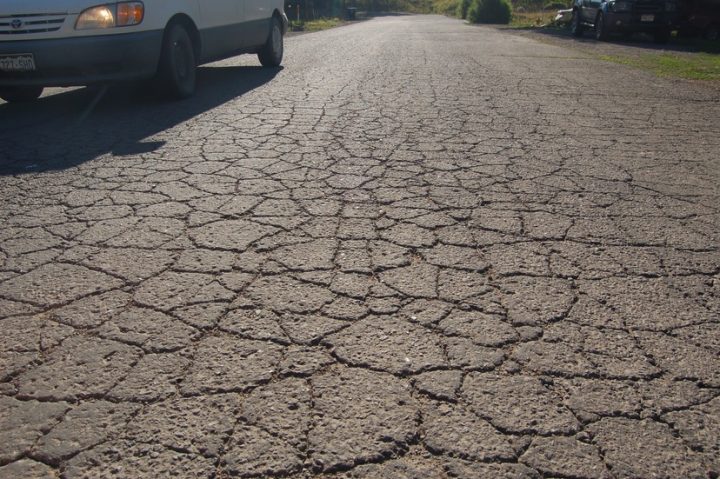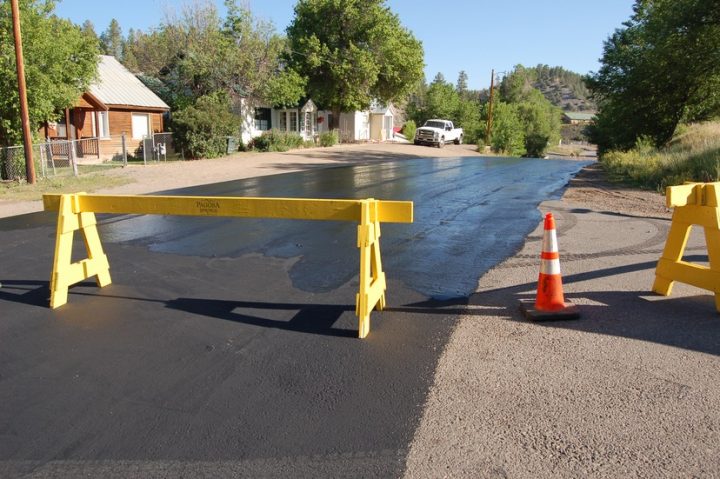But lay up for yourselves treasures in heaven, where neither moth nor rust doth corrupt, and where thieves do not break through nor steal…
— Matthew 6:20, King James version
Some thoughts about corrupted earthly treasures — physical, and conceptual.
Daily Post columnist Glenn Walsh wrote an op-ed last week, questioning the use of a Colorado “urban renewal” law by the Town of Pagosa Springs, for purposes that may have nothing to do with “urban renewal.” Those purposes might include the creation of new streets within the Town boundaries — in a community that has historically struggled to properly maintain the streets it already owns.
Late last month, as my friend Greg Giehl and I walked through the Bienvenido Circle neighborhood just north of downtown Pagosa Springs, I noted with appreciation the freshly-applied crack sealing on the asphalt, courtesy of the Pagosa Springs Streets Department.
Greg and I were distributing information about Ballot Question A, a citizen-sponsored initiative that — if approved on July 14 — would give Town voters an active voice in the use of Tax Increment Financing (TIF) subsidies before those tax monies can be granted to developers and corporations by the Town’s new Urban Renewal Authority. Of course, this citizen effort is intimately connected with streets — both old streets, and new — because governments use tax revenues to maintain our streets and roads. When wealthy developers and corporations get special treatment and end up paying no taxes, the rest of us suffer the consequences.
Greg and I were encouraging our neighbors to mark “Yes” on their ballots, to provide the Town voters a voice in such matters. (County voters, unfortunately, are not allowed to vote on Town issues.)
Bienvenido Circle is one of the lucky Town streets to receive regular crack sealing, a process that helps prevent corruption of the asphalt.
As far as I can recall, my own downtown street, Loma Street, has never had its cracks sealed… in all the 26 years I’ve lived in my house. At this point, the asphalt cannot be saved, and the Town would be wasting their time trying. Asphalt in this condition is referred to as having ‘alligator cracks.’ It’s beyond help.
When the corruption has gone this far, you simply allow the asphalt to completely fall apart until you have the money to do a complete reconstruction. But with newer asphalt like Bienvenido Circle — you can actually extend its useful lifespan by sealing the cracks, or better yet, by applying a seal coat.
Here’s another lucky street: North 5th. A few days ago, the Town Streets Department gave most of this street a protective ‘seal coat’ — to help slow the corruption of the asphalt.
But when the corruption has gone too far…? What then?
A friend of mine reminded me, last week, that the English language is useful for telling the truth — but it really shows its versatility when you want to practice deceit. We’ll dig into that interesting idea later in this editorial series, but first let’s consider a Greek word.
ἀφανίζει
Two centuries ago, an author known as ‘Matthew’ shared the discourses of a famous Jewish teacher, writing in Greek. He transcribed one particular teaching this way:
θησαυρίζετε δὲ ὑμῖν θησαυροὺς ἐν οὐρανῷ, ὅπου οὔτε σὴς οὔτε βρῶσις ἀφανίζει, καὶ ὅπου κλέπται οὐ διορύσσουσιν οὐδὲ κλέπτουσιν·
When this teaching was translated into Elizabethan English during the creation of the King James Bible in 1611, the scholars translated the term ἀφανίζει as “doth corrupt.” Later translations picked various other English terms. “…doth consume”. “…turn to dust”. “…destroyed”. “…spoiled”. These scholars were obviously seeking a term that implied a time-dependent process, to express the ephemeral nature of any “treasure” we might choose to lay up for ourselves here on earth.
“Corruption” is a process that takes place over a span of time. In a moment, we’ll look at an entertaining video about Littleton, Colorado, and the corruption that was unfolding there in 2016, at the hands of their Urban Renewal Authority. But now that we’re clear that corruption takes place over a span of time, and is not always predictable… some quick background on CRS 31-25-102, Colorado’s Urban Renewal Law.
Back in 1958, Colorado passed an “Urban Renewal Law” that was closely modeled on the Federal Housing Act of 1949, which was in its turn designed to address slums, disease and crime in some of the nation’s larger cities. Both federal and state laws seek to address the social problems and threats that come from people living in substandard housing, amidst squalid conditions, and both laws refer to “disease” and “crime”. Disease and crime are what make slums and blighted areas worthy of statewide interest, and warrant property tax diversion and, possibly, condemnation efforts.
In the eyes of Colorado legislators, the high level of threat from slums and blight was the reason for greatly expanded municipal taxing and financing authority.
By the mid-1970s, however, there were few neighborhoods left in Colorado that could properly be described as “slums.” On top of that, the federal funding that had been financing urban renewal projects had pretty much dried up. So the state of California invented a new type of tax-supported funding called Tax Increment Financing (TIF). Colorado followed California’s lead, by inserting TIF financing into its Urban Renewal Law, in 1975.
That’s when the corruption really got going. Cities began to use their powerful, uncontrollable Urban Renewal Authorities (URAs) to address not dangerous, crime-and-disease-infested slums and blight, but rather, to finance ‘economic development’ projects on undeveloped vacant land that posed absolutely no threat to anyone.
City councils promoted themselves from public servants taking care of streets, to become development bankers financing brand new streets and infrastructure — and able to hand millions of dollars in corporate welfare to whatever developers the URA deemed worthy.
Here’s a 2016 interview by “Devil’s Advocate” Jon Caldara with newly elected Littleton City Council member Doug Clark. I hope you can watch the entire 12 minutes. I couldn’t summarize the issue any better than they have.
Tomorrow, Tuesday July 14, the voters living within the Town of Pagosa Springs boundaries will have a chance to require voter approval for large TIF projects here in our little community.




